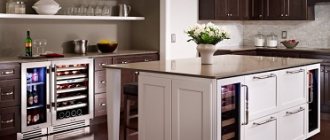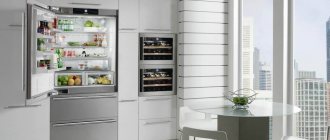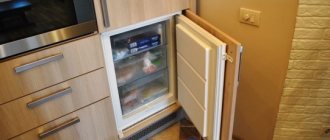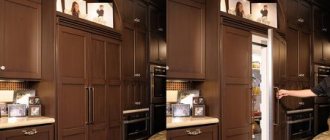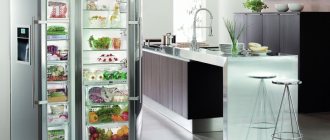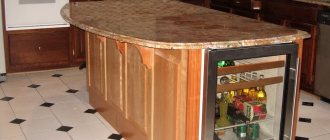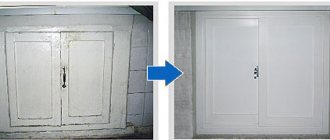A refrigerator is a basic necessity in modern kitchens. Its purpose is very high. For the food products it contains, their sales time increases significantly. You can cool drinks in it and store necessary medications that require a certain temperature regime.
In addition, you can freeze fish, meat, semi-finished products and much more in it for a long time. If you install the refrigerator correctly, its service life will be extended. For this reason, we approach this issue very responsibly.
Pros and cons of built-in models compared to conventional ones
Before buying a built-in refrigerator, you need to carefully study and analyze all the advantages and disadvantages of such a solution. In some apartments it is more advisable to install conventional models. Especially in cases where the family is large and you need to store a lot of food at once. Here are the main pros and cons of built-in refrigerators compared to free-standing ones:
Pros:
- It's easier to make a choice. When purchasing a device with a built-in design, you don’t have to worry about choosing the design, texture, color of the coating, as well as whether it will fit other household appliances and kitchen furniture. Since the refrigerator is built into a cabinet, it will not stand out from the overall interior. The main thing is to choose the right size.
- Energy saving. Decorative panels improve thermoregulation, maintaining the required temperature in the chamber, thanks to which they have less energy consumption.
- Soundproofing. The panels add additional thickness to the walls of the refrigerator, thereby muffling the noise from its operation.
- Space saving. Built-in models are considered more compact than conventional ones and take up less space in the kitchen. You can easily place a microwave, multicooker or other large appliances on them to save space.
Minuses:
- Can't be moved. If the refrigerator is part of the kitchen furniture, it cannot be moved to another place. But a free-standing device can be moved.
- Small size. A characteristic feature of built-in refrigerators is the small size of the chamber. Such devices are not suitable for people who like to store a lot of food.
- Cannot be defrosted. Defrosting can damage decorative panels. This is especially true for wooden coverings, which are then difficult to restore to their original form.
- Higher cost. Built-in models differ from conventional refrigerators in their high price. This is due to the complexity of manufacturing and installation. In addition, it is not always possible to find a box that matches the color, and an individual design costs a lot of money.
Recommended base for refrigerator
Such a massive, heavy structure needs a flat, non-slip and hard surface. If the concrete floor is tiled, there will be no problems. If the floor finishing is made of wood material, you need to make sure that its elements are sufficiently firmly fixed and can support the weight of the unit. In addition, vibrations come from a running compressor. If the floor is moving, they intensify and spread in waves across the surface of the coating. Not only will the device quickly break down, but it will also irritate the household.
How to properly level a refrigerator: stages of operation
The refrigerator must be placed on a flat floor surface. Some people have tile floors in their kitchens. To prevent the refrigerator from moving on the floor and causing slipping, it is worth buying special stickers for the legs. You need to adjust the front legs so that it stands level. After installing it on the floor, it is checked whether it will stand level when the door is opened. The refrigerator should not wobble when opening and closing or make strange sounds. The legs can be adjusted manually or with a key. This way you can adjust the desired tilt of the refrigerator and align its position relative to the floor and walls.
The surface on which the unit is installed must be level. So that the device does not wobble. For this purpose, the refrigerator has special adjustable legs.
Installation steps:
- Choose a place for the refrigerator;
- Check the floor surface for evenness;
- Unpack the refrigerator;
- Place in the chosen place;
- Adjust the height of the legs.
To set the correct level, you can use special devices. To adjust the level, you can use a plate with a recess, which will have a small strip on the edge.
The refrigerator should not be installed close to the wall. It is necessary to leave a gap of about five centimeters between the wall and it to allow air circulation. After these level installation steps, taking into account all the rules, installation to the electrical network occurs.
How to put a microwave on top and is it worth it?
In small apartments, a microwave oven is often placed on top of the refrigerator. This makes sense if the unit is small and you will only heat and defrost food in the oven. Other microwave functions—long cooking, grilling, multicooking, and others—will quickly lead to overheating of the device.
Consider other rules:
- the distance from the wall to the microwave is the same as that of the refrigerator: 10–15 cm;
- Lay plywood or plexiglass between electrical appliances. Film, oilcloth and other flammable materials - under no circumstances;
- The microwave should be equipped with legs so that the gap between the units helps to increase air circulation.
Advantages and disadvantages
If there is a suitable place in your kitchen, then you can equip a special niche in it. It is advisable to do this before finishing. To begin with, a suitable metal profile is selected, and then it is covered with plasterboard. It is also possible to install a door for a niche, which may have a sliding or other type. If you implement this idea correctly, you will get a design like built-in kitchens.
When arranging a niche, metallic-colored refrigerators are often chosen. This color looks stylish and is easy to match with metal ovens, stovetops, dishwashers and other appliances. White refrigerators also look good in niches. There are many similar interior solutions using white cabinets.
A design solution such as installing a refrigerator in a niche has its advantages and disadvantages. Let's look at the advantages in more detail.
- The external arrangement of the kitchen immediately benefits. Even if the refrigerator door remains the same, it will look much more organic. And if there is also a shelf or cabinet above it, made in the style of kitchen cabinets, then the room will change beyond recognition.
- After installation in a niche, the refrigerator will make less noise.
- The influence of harmful factors on the refrigerator mechanism - dust, sunlight, pollution - is minimized.
- This technique contributes to a more rational use of free space in a small room.
There are also some disadvantages.
- This kitchen design option will require additional financial costs.
- Often, refrigerators with an additional cooling element and increased thermal insulation (and it is better to choose these for embedding in a niche) are less economical in energy consumption.
- Loss of usable space. To prevent the refrigerator in the niche from overheating, you need to leave gaps between it and the walls of the box - 5 cm on the sides and the same amount at the back. And to open the door, a few centimeters on at least one side are simply necessary. In Khrushchev-era kitchens, which are small in size, this point can make arranging a niche impossible.
If the kitchen is large
A large kitchen is the dream of any housewife, because its large size allows you to realize all your kitchen ideas and use the maximum number of stylish and useful kitchen items.
Placing a refrigerator in a large kitchen has virtually no barriers, because it can be installed:
- Traditionally - in one of the corners, in which there are no radiators - such placement is not only familiar and convenient, but also meets the requirements for the ergonomics of the room, the convenience of being in it and even the instructions of Feng Shui, since it visually makes the kitchen “softer” and “rounder” ;
- Centralized - the design idea is quite capable of making this device the center of the entire kitchen, especially if the refrigerator itself has significant dimensions and rich functionality, such as, for example, a TV screen built into the front panel or buttons and compartments placed on the doors for serving drinks from the cooling chambers; in this case, the rest of the kitchen set is built around this device and matched to its “style”;
- Individually - if the room allows, then the refrigerator should be allocated its own individual part of the territory, not in contact with other kitchen appliances or kitchen furniture; at the same time, you can create a stylish and interesting design of wallpaper or wall coverings, against which the refrigeration unit will be placed.
Instructions for correct installation
Usually, household appliances come with instructions with detailed rules for transportation, installation, first use and maintenance. If you don't have it at hand, follow the rules:
- If the refrigerator was transported horizontally, wait two to three hours before using it for the first time.
- The recommended distance from the wall to the rear panel of the unit is 10 cm. 5 cm is possible, but air microcirculation will worsen.
- Provide free access - the door should open freely to the maximum angle.
- To prevent slipping, use silicone or plastic stickers on the floor - the unit will make less noise and will not “run” around the kitchen.
- There should be no sofa or kitchen corner near the appliance. If it is not possible to change the layout of the furniture, it is recommended to position the refrigerator so that the distance between it and the interior items is at least 10 cm.
If you follow these rules, the risk of overheating of the mechanism, loss of power, failure of the defrost timer or other components is reduced.
How to move or relocate correctly
The refrigerator can be rolled around the kitchen using a pair of rear wheels. We tilt it back a little and pull the lower part towards us.
Avoid sharp tilts - the device can be dropped onto the floor with its radiator. After such a fall, not all units continue to work; repairs are often required.
Secure the power cord to the grille on the back of the device. If the wire drags along the floor, it is easy to break it, break it, or damage the insulation. For fixation, fasteners are used - plastic clamps.
Electricity and cables
To ensure safe operation of the device, connect it to the electrical panel via a circuit breaker (RCD). Ideally, allocate a separate outlet for the refrigerator. As a last resort, use an extension cord - but only one.
If you cannot connect the unit to a separate outlet, use a surge protector - it will ensure the safety of equipment of any brand (AEG, Beko, Electrolux, LG, Indesit, Samsung, Whirlpool, Bosch, etc.). If there is a voltage drop, the external fuse will burn instead of the delicate electronics.
Alignment by level
Install the refrigerator in the chosen place so that it stands motionless and level, otherwise it will beat, “jump” and “walk” around the kitchen. The fact is that during operation of the compressor the device vibrates, so on an uneven surface it constantly moves. This negatively affects the main nodes.
Adjusting the front legs
Adjust the position of the front legs so that the refrigerator doors close automatically under their own weight. The legs are two plastic washers with bolts located at the bottom front. They allow you to change the angle of inclination of the unit by 1–2 degrees. The magnetic seal will do its job and seal the chamber.
If the floor is flat, without drops (for example, self-leveling or industrial), simply place the equipment in the right place and adjust the position of the front legs. If the floor is uneven, check the slope using a building level.
- Tilt the device back slightly so that your feet are in the air.
- Manually rotate them clockwise (to decrease the height) or counterclockwise to achieve the optimal position.
- Carefully lower the equipment and check the bubble at the construction level.
The final stage
- As a final step, install the shelves in the upper compartment and the drawers in the freezer.
- Change the position of the thermostat by selecting medium temperature mode.
- Perform the first startup of the device, plug the plug into the socket.
Adjusting the refrigerator door if the plastic spacer is faulty
In most cases, problems with the plastic spacer appear in older refrigerators. A similar problem is accompanied by the door sagging or moving downwards. To close the camera, you need to lift and slam the door. However, this will not solve the damage, so the spacer will need to be replaced.
To avoid breakdowns, you need to follow simple rules:
- Avoid sharp slams of the door, as this negatively affects the condition of the spacer, fasteners and seal.
- Do not overload the door shelves with food or other items. Otherwise it will be skewed.
Examples in the interior
Arranging household appliances during a kitchen renovation is a fairly important and responsible process. You can diversify and decorate the kitchen interior in different ways, and a niche for a refrigerator is one of such solutions. The main thing is to think through the entire interior as a whole, and perhaps an experienced designer will help you with this. Or use our tips, study examples and feel free to implement your ideas yourself.
A white kitchen easily matches a plasterboard niche of the same color. A shelf was made above the refrigerator so that the overall size of the niche corresponded to the height of the cabinets.
In this photo, the niche has fairly dense walls, the interior looks holistic and harmonious. The niche not only hides the sides of the refrigerator, but also protects it from sunlight from the window and from dirt.
Installation of a built-in refrigerator
As for installing built-in models in a niche, cabinet or work surface, the ideal flatness of the floor and the presence of free air access are also taken into account. In this case, manufacturers of custom-made furniture take into account all these nuances:
- the height of the cabinet or niche is 3 cm more;
- depth – 4-5 cm more;
- width – 1-2 cm more;
- ventilation is required: an option with a lattice rear wall or partial use of the side wall, even holes in the floor are possible.
All of the tips listed in this article will help you both install the refrigerator correctly and extend its service life. They will ensure economical and safe operation, which is of great importance during warranty repairs by the store in the event of a breakdown.
How to install a refrigerator correctlyTransport and unpacking
It is advisable that the transportation be carried out by representatives of the company or retail outlet where you purchased the device, as they will do it professionally and safely. In the case of self-transport, it would be reasonable to check the working condition of the refrigerator on site and require the seller to fill out the accompanying documents and warranty card.
It is important to remember that the refrigerator should not be transported lying down, subject to shocks and shaking, as serious damage can be caused to the device (damage to the housing, deformation of parts, leakage of freon).
After delivery, unpack the refrigerator, carefully remove the packaging material and store it. This is necessary so that if any deficiencies are found, you can return the refrigerator back. In this case, you must also have all the accompanying documentation. According to the instructions, check the package contents; if there is any discrepancy, notify the delivery service or the organization that sold the refrigerator.
Correct installation of the refrigerator
It is important to know how to install a refrigerator correctly! Whatever type of kitchen you have, you should definitely consider the installation rules. By following them, you will not only be able to comply with safety precautions, but also provide your refrigerator with many years of service life.
After all, you must admit, this is not an item that we buy every year
By following them, you will not only be able to comply with safety precautions, but also ensure that your refrigerator has a long service life. After all, you must admit, this is not an item that we buy every year.
When installing, consider the following factors:
- 1. When cooling food, the refrigerator gives off heat, so the distance from it to the wall should be at least 10 cm. Moreover, the wall should also not be warm so as to create excessive heating of the device. If older models had rear ventilation - i.e. This rule concerned the location of the rear wall, but modern refrigerators have ventilated side walls, which greatly simplifies the installation situation.
- 2. For the reason mentioned above, you should not place the refrigerator near heating devices - gas stove, oven or radiator. The recommended optimal distance is 50 cm. You should also avoid overheating the unit body - it is better not to expose it to direct sunlight. This is especially true if your kitchen is located on the sunny side.
- 3. Unlike a gas stove or sink, a refrigerator has greater freedom of “movement”, because it is only tied to an outlet. But there are some nuances here too:
- it is desirable that the connection be made directly, without extension cords and adapters;
- The refrigerator wire is usually not that long, so the outlet should be nearby;
- the socket should be installed away from the sink and stove;
- The possibility of grounding the connection is welcome.
The refrigerator must be installed on a flat floor, otherwise it will make unnecessary noise or not work correctly.
4. And one more thing. By taking this into account, you can avoid a number of inconveniences and possible injuries - don't forget about the door! Modern models have a mechanism that allows you, if necessary, to rearrange the handle and change the direction in which the refrigerator door will open. But not all models can boast of this. Therefore, we recommend that you familiarize yourself with the characteristics of the device before purchasing.
Protection of refrigerators from voltage surges
Refrigerators are extremely sensitive to power surges. The slightest voltage surges affect not only the efficiency of these units, but also their serviceability as a whole. The main reason for sudden voltage drops is the design imperfection of our electrical networks. It is impossible to predict these differences, so voltage relays and stabilizers are used to protect home appliances.
Voltage control relay
It is recommended to install a voltage control relay when power surges are quite rare and the voltage in the home network is generally stable. This relay is a device that has the ability to read electrical current parameters. When the voltage goes beyond the specified range, the relay breaks the electrical circuit.
After normalization of the voltage in the general electrical network, the relay automatically closes the circuit and resumes power supply to energy consumers. This device also has a built-in power resumption function with a delay (after a certain period of time), which is especially important for refrigerators, which, in the event of a short-term power outage, are recommended to be plugged into the network 5-10 minutes after the power supply is restored.
Modern voltage relays come in three types:
- stationary, which are built into the electrical panel of an apartment or house;
- to protect one consumer (device);
- to protect multiple consumers.
The first type of relay has the most complex design and is mounted at the entrance to the room. It protects all equipment in the house from voltage surges, but its installation requires certain knowledge. It should also be taken into account that the relay protects the network from unacceptable voltage surges, but not from short circuits. For this purpose, circuit breakers are used.
When choosing a voltage relay for your home, you should know the rating of the electric current that the input circuit breaker can pass through. For example, if the switch capacity is 25 Amps, which corresponds to a power consumption of 5.5 kW, then the performance characteristics of the voltage relay should be one step higher, that is, 32 Amps (7 kW). If a 32 Ampere switch is used, then the relay must withstand an electric current of 40-50 Amps.
Surge Protectors
In the case where there are constant voltage drops in your house, the relay will operate several times a day, de-energizing the entire house. In this situation, a more practical, albeit more expensive, method of protecting home electrical equipment is recommended. It consists of using a voltage stabilizer. This device is capable of smoothing out voltage drops in the external electrical network and producing a constant output value of 220 Volts.
Stabilizers, depending on the type of connection, can be local or stationary. Local ones are connected to an outlet and protect from one to several devices. Stationary stabilizers are connected to the input power cable and protect all household electrical equipment.
Local stabilizers are recommended to be used to protect the most sensitive household appliances. They can be used in conjunction with a stationary voltage control relay. Stationary type stabilizers are quite complex devices that are capable of not only smoothing out voltage drops throughout the entire home network, but also automatically turning off the power when it reaches critical values.
The main criterion when choosing a stabilizer is power. A stationary stabilizer should have a power 15-20% greater than the total power of all household electrical appliances used in the house. The power of the local stabilizer should be the same 15-20% higher than the power of the protected device, for example, a refrigerator.
Types and models of built-in refrigerators
The modern market of household appliances offers many options for kitchen “helpers”. Depending on the location of the unit relative to the furniture body, the following types of devices are distinguished:
- Fully built-in. The appliances are hidden behind the facade of the kitchen; the presence of a refrigeration unit can only be guessed by a special grille.
- Partially hidden. The device is completely “recessed” in the box, only the doors or control panel are visible from the outside.
Depending on the number of cameras there are:
- Single chamber models. These are products without a freezer, or it is located inside the main chamber. Usually these are small models that can be easily integrated into the bottom row of a kitchen set. Often a dishwasher or washing machine is installed at this level.
- Two-chamber. These are separate refrigerator and freezer compartments, they are equipped with separate doors.
- Multi-chamber. They consist of several sections, in each of which the optimal temperature is set. Typically, cameras are not located vertically, but next to each other. The doors of such models open in the same way as the doors of a hinged cabinet.
Depending on the location of household appliances, there are models designed for installation:
- Under the countertop. An ideal solution for small kitchens where every centimeter plays a decisive role. To save space, the unit is mounted under the dining table. This non-standard solution ensures a comfortable and convenient pastime in the kitchen.
- On the work surface. Usually these are small-sized devices, the height of which does not exceed 85 cm. As a rule, offices, cottages and small kitchens are equipped with such devices.
- In the closet. The most common type is suitable for kitchens of various sizes and configurations. It is a column that fits perfectly into the overall style of the interior.
- On the island. An interesting option that is preferred by owners of spacious kitchens. In this case, all equipment is located in the center of the room. This is where the work area and washing area are organized. This area is also used as a bar counter. It is very convenient to place a refrigerator here in order to provide convenient and quick access to food and drinks.
- In a niche. The method is suitable for rooms where there is a well-ventilated corner. In this case, all work is carried out at the initial stage of repair.
How to distribute shelves in the refrigerator?
Agree, when it is not clear where everything is in the refrigerator and there is no free space in it, it is inconvenient. To prevent this from happening to you, you must initially correctly install the shelves in the refrigerator and organize the space.
There are seven simple rules for this:
- Start with an empty refrigerator. Pull out all shelves and remove spoiled food.
- Store butter and cheese on the door. If these are closed sections, then it is better to place them on the top shelf of the door. There is no such? Then simply place the food on the top shelf of the door.
- You can put sauces, dressings, etc. on the remaining shelves of the door.
- It is better to store drinks on the highest shelf, usually at the top.
- Fill the bottom drawers with fruits, vegetables, herbs, meats and sausages that do not need to be frozen. At the same time, store vegetables and the like in separate boxes with meat products.
- Place dairy products on empty shelves. And the remaining space can be used for ready-made dishes.
- Store frozen meat, minced meat, fish, vegetables, fruits, etc. in the freezer. It will be great if you have a separate drawer for seafood, another for meat, and a third for everything else.
Compact models for small kitchens
Modern refrigeration units are large in size. For a large kitchen and family it is convenient and practical. For small rooms you need small compact models. Manufacturers take this into account and make units of different sizes. Let's look at the top 3 compact models.
Bravo XRD-120
Two-chamber, with independent freezing and refrigerating chambers. Quite tall, but in a small kitchen it will be comfortable with such a refrigerator. Dimensions - 45x50x119 cm. Freezer volume - 35 l, refrigerator - 73 l. The temperature is adjusted electromechanically. If there is a power outage, the products will not be in any danger for six hours.
Candy CCTLS 542 WH
Has two chambers, one common door. Dimensions - 45x55x85 cm. Freezer volume - 7 l, refrigerator - 125 l. The low weight of 30 kg makes it possible to install (build in) at a short distance from the floor, taking into account the height.
Supra RF-096
Two-chamber model with one door. Dimensions - 45x47.2x85 cm. Freezer - 8 l, refrigerator - 85 l. The noise level is only 29 dB, which is convenient when installed in a studio apartment.
Installation of a built-in refrigerator
Installing a built-in refrigerator is a painstaking and complex process that requires a number of skills and equipment. Therefore, many users turn to specialists for help, wanting to save time and money, because... If done incorrectly, the equipment may be damaged.
Regardless of the installation method, you should study the step-by-step guide in detail.
Installation process
The algorithm for installing equipment is as follows:
- First, you need to take the equipment out of the factory box, remove the film from all parts and make sure that the components, fasteners and factory documentation are present. If the package is incomplete, you should contact the store where you purchased the device.
- Next, you should evaluate the compliance of the dimensions of the equipment and the parameters of the space for installation. In specially designated areas, openings should be provided for free air circulation.
- At the next stage, the horizontal placement of the pencil case is checked using a building level. If any irregularities or deviations are present, they must be corrected.
- Afterwards, the device is removed from the restraints and transferred to the main place. At this stage, you can leave free space in front of the front for comfortable placement of the doors.
- Electrical cables are placed above or below the refrigerator and secured.
- Next comes the installation of protective panels, which are used to mask fasteners and doors.
- Metal parts are sealed and covered with decorative inserts.
All that remains is to install the camera at the desired level and secure it using fasteners. Finally, the device is connected to the power supply and checked for any malfunctions or errors in operation.
They make it easier to solve the problem yourself and allow you to avoid troubles at various stages of installation.
External door
If the equipment is completely installed in a cabinet, it must be closed with a front door. You can carry out the installation yourself, following generally accepted algorithms:
- By means of runners that allow the door to slide in relation to the front part.
- By means of fixed hinges.
In 2 cases, there are some subtleties that require equipment skills. Therefore, to avoid problems, you must carefully read the instructions.
Electrical connection
To connect the refrigerator to the electrical network, it is important to determine the location and technical parameters of the outlets. If the building is undergoing general renovation and it is possible to change the location of the outlets, you need to move them to the most convenient place with easy and simple access
At the stage of connecting electricity, it is worth considering the following subtleties:
- Do not place the device in such a way that the socket remains behind. This will cause a number of inconveniences when connecting. In addition, gaining access to the outlet in the event of a short circuit will be problematic.
- If the device is connected to one outlet using adapters or extension cords, it is necessary to evaluate the total load on the network.
- It is better to place the socket under the tabletop, in the side part of the set.
Adjusting the refrigerator door when there are gaps in the seal
The rubber seal is an important element of the refrigeration chamber, which is responsible for insulating the internal space from external heat. If the rubber band wears out, warm air will flow inside the refrigerator, which will lead to condensation and additional problems.
Over time, the surface of the rubber becomes covered with dents and gaps, and the initial elasticity is lost. If you do not take the necessary measures and do not overhaul the refrigerator door, the device may fail. This is explained by the fact that when the seal is lost, it operates at peak loads and is subject to severe wear. Ignoring the problem will lead to unnecessary costs.
With prolonged use of the refrigerator and lack of care, the rubber seal will begin to become clogged with household debris, crumbs and other contaminants. To get rid of them, you can use the following methods:
- Treat the rubber surface with a soft sponge soaked in an alcohol-based cleaner.
- Apply a solution of soda and vinegar to the seal. Such substances do not cause damage to surfaces, but restore the purity of rubber.
- Do not use compositions with abrasive impurities for cleaning, as they can damage the part.
If the seal cannot be restored using the methods listed above, the seal will have to be replaced. The degree of wear is determined by the following characteristics:
- Yellowness appeared on the rubber and it became hard, especially in the corner areas.
- The surface was covered with small cracks.
- To restore its original shape, you need to treat the seal with hot water, pouring along the perimeter.
There are other ways to restore the seal. This could be rehanging the door to calculate optimal placement, or treating it with a stream of hot air from a hairdryer.
Using this method, you must adhere to the following instructions:
- Disconnect the device from the outlet.
- Start heating the rubber with a hairdryer to 80°C.
- Straighten all problem areas with your hands (to protect yourself from injury, you need to wear linen gloves).
The heated area should cool down on its own when the chamber is closed. This technology is only suitable for simple breakdowns.
A popular solution for seal repair is boiling water. The gum is placed in hot water and left there for a while to swell. After increasing in volume, the tightness of its fit will be restored. The method has a significant drawback. The seals in the latest refrigerator models are secured with glue or foam rather than bolts. When removing the rubber band, you can easily damage it.
If the refrigerator door is sagging due to problems with the rubber part, you can treat it with a steam iron. The door is removed and placed on the floor, after which gauze and an iron are placed on the rubber surface. When exposed to steam, the rubber will straighten.
If the seal is severely damaged, you can send the refrigerator to a service center, where the part will be replaced with a new one. If there is a warranty, it will be serviced free of charge. In other cases, you will have to pay for the services of specialists or change the part yourself.
If severe cracks and sagging appear, it is not advisable to smooth or soak the elastic. You can find many spare products on sale, and repairing a refrigerator door by replacing the seal does not require special skills or effort.
Replacing an elastic band yourself requires following certain rules and taking into account a lot of nuances. Polyvinyl chloride is used to make such products. They may differ in format, fastening method and other features depending on the model of the refrigerator compartment.
If the rubber band is fixed around the perimeter of the door with screws or recessed into a special groove, the replacement will be completed as quickly as possible. When gluing a part into a door, you will need the help of specialists.
Seals for modern cameras are sold in every household appliance store. However, if we are talking about replacing a part for a rare camera, a lot of problems can arise here. It is not easy to find original rubber bands for such units, so you will have to use your imagination and select alternative solutions. So, you can use a large compactor and cut off excess sections horizontally and vertically.
Refrigerator with ice maker and water connection
A refrigerator with a built-in ice maker must be connected to a water system. The process is not complicated, however, first you will need to think through all the little details when installing the equipment, as well as purchase special hoses and adapters; you should also take into account that if the ice maker is built-in, an extension cord may be required. Some new models are not designed to be connected to a water supply and here you will have to pour pre-purified water into the tank yourself. It is located inside the refrigerator compartment and is connected by a hose to the ice maker. After about a few hours, the water hardens, the mold automatically turns over, and the ice falls out of the molds into a special storage chamber.
One cannot help but pay attention to the advantages of such refrigerators:
- Most new models are designed for continuous operation. It is thanks to this functionality that the ice will not be stored for a long time, but will be renewed, as a result it will always be fresh.
- Some refrigerators have a touch panel that allows you to control and select specific ice. But such models are usually expensive.
- You can purchase equipment with an ice generation function. Here, a special sensor will monitor the availability of the product for preparation, and if the ice cell is empty, the system will signal to prepare a new portion.
- Some models have a dispenser function, so, for example, you can fill a glass with cool liquid or ice without opening the refrigerator door.
Properly installing an ice maker with a water connection is not difficult. Installation involves connecting to the cold water supply using a hose and after connecting to the water supply, all that remains is to connect the installation to the electrical network. DIY installation is fully described in the video. An ice maker in the refrigerator can be called a modest addition, but its presence in the house will make it possible to get a cool drink at any time, and ice can be an original addition to any dish.
Video: hang the door on the refrigerator with your own hands
Hang the door on a hotpoint ariston refrigerator with your own hands
Watch this video on YouTube
Do you want to understand better than others?
- Adjusting the Indesit refrigerator door - Why is this necessary? As practice shows, the right-side location of the refrigerator door is not always convenient enough. The solution to the situation was overhanging doors...
- What is the best way to lubricate refrigerator doors? — The refrigerator door can make annoying squeaking noises, just like any other appliance. The lubricant inside the hinges wears off after a certain period of time. This leads to…
- Do-it-yourself refrigerator door repair - Replacing old household appliances with newly purchased ones is a task that not every person can afford. A refrigerator is quite important for maintaining a normal home life...
- Removing the refrigerator door - Step-by-step removal of the upper door of the refrigerator To complete all work, you will need operating instructions for the refrigerator from which the door will be removed...
- Removing and Disassembling a Refrigerator Door - How to Disassemble a Refrigerator Door to Re-Hang It on the Other Side At the very top of the refrigerator, above the freezer door (you may need a ladder), remove two...
Refrigerator in the kitchen with a ledge or niche
Do not panic if the kitchen space is not only small, but also has a non-standard shape and layout. In this case, the refrigerator becomes a real salvation instead of a problem. You may have to look for an option of an unusual size - for example, not too deep, but the result will be an original play on the ledges and extra corners of the kitchen.
It will look especially stylish if the non-standard shape of the room is also emphasized with a bright shade of a prominent wall. An interesting design trick is to paint the door the same color. But it is better to leave the kitchen set neutral-light, ideally white. The same applies to the remaining walls: visual expansion of space in a small kitchen is necessary, and bright accents should remain bright accents, giving the main role to light colors.
If there is a niche in the kitchen, even better, you can put a refrigerator in this niche.
The main causes of hinge failure
Damaged Hinges – Refrigerator hinges may be damaged or loose. After all, they are the most stressed and perform work almost non-stop. Damage or loosening may be caused by, for example, bending or breaking of the fastener. Sometimes we try to close the refrigerator when food gets caught between the door and the shelf - this is one of the reasons why the refrigerator door hinge breaks. In this case, damaged hinges must be replaced. If we cannot complete this task alone, then a technician from Fix-Man repair service comes to our aid.
Preparing the refrigeration unit for operation
A flat surface is the first thing that needs to be prepared. If the floor has defects, adjust the legs of the refrigerator. To prevent slipping, use silicone or plastic stickers. Otherwise, vibration of the unit will lead to premature wear of the equipment.
Temperature compliance
Placement away from heat sources - heating devices, electric and gas stoves. You cannot place the refrigerator near a window. Direct sunlight negatively affects engine performance and disrupts thermoregulation.
Providing a ventilated space. By cooling the refrigerator and freezer compartments, the compressor heats up. The walls of the mechanism need ventilation, which prevents hyperthermia.
Ambient temperature – not lower than +10 °C. At zero, freon thickens and the refrigerator fails.
Long-term operation of the unit also depends on the following factors:
- The humidity level should not exceed 75%. When damp, the metal corrodes and conductivity increases.
- Grounded socket. Failure to comply will result in electric shock and fire.
- Proximity to household appliances is prohibited. Even a coffee maker can affect the operation of the mechanism.
- The use of extension cords or tees is not advisable. Leads to breakdown of the stabilizer, which protects the refrigerator from voltage surges in the network.
- Positioning close to a wall is dangerous for vulnerable components located at the rear of the unit.
- Installing a refrigerator in a residential area is not recommended. The mechanism makes noise - especially undesirable for families with small children.
- Placement next to the sink. Splashes contaminate the surface, create increased humidity, and cause short circuits.
Important! If operating conditions are violated, the owner loses the right to warranty service
Basic rules for choosing a location
For any installation, you need to take into account the features of the room:
- what flooring is in the apartment - quality, material, presence of differences (the latter is relevant for “Khrushchev” buildings),
- is there a dedicated wire from the input electricity meter,
- how far away are sockets, heat and water sources,
- and how the unit will look in the interior with existing furniture.
Let's look at the rules in order.
Floor - durable
Before installing indoors, carefully examine the floors - they must be strong enough and motionless. You cannot install a large-sized refrigerator on a coating that is soft (4-5 layers of linoleum) and springs freely - for example, on boards up to 3 cm thick, located with a large gap. Due to vibration, the motor will hum louder, especially at night, and will soon fail.
If the covering is plank and springy, protect the floor surface with plywood at least 4-5 mm thick.
It is better to install the equipment on concrete - such a floor will withstand even a two-door, two-chamber unit of maximum height. The coating can be finished in any way, but for large equipment a tiled base is more suitable.
Warmth - away
To install a freezer and refrigerator, consider areas of the room far from heat sources. If you do not follow this rule, the unit will quickly fail. The compressor operates constantly, because the device heats up, as a result, the air inside the chamber needs to be cooled regularly. If used for a long time in such conditions, the thermostat fails, and soon the engine fails.
When installing a refrigerator, you should consider the location of the window in the room.
For the same reason, refrigerators and freezers are not placed near windows - in the summer they heat up just like radiators and break down faster. The exception is cases when there is an air conditioner in the room.
It is also impossible to place such equipment next to a gas or electric stove - if the stove is used frequently, it generates a lot of heat.
Minimum distance from heat sources: from the radiator - 30 cm, from the stove - 50 cm.
Sockets - closer
Pay attention to the presence of sockets nearby. The best option is to have a power source near the device.
- Include a direct wire from the electrical panel into the project during the construction phase.
- Buy sockets with grounding (small antennae on the body).
- But even if there is no outlet nearby, do not use multiple extension cords. All the energy from them will accumulate on the first “tee” connected to the plug, the network will be overloaded - and this is a serious risk of fire.
Water is the enemy
Do not install the refrigerator near sinks, taps, washing machines and water pipes: even if they are not close together, splashes will still reach the refrigerator - and you will receive an electric shock from the body. The ideal distance from the water is 2-3 m.
Where to start installing a refrigerator
Let's start with the fact that upon purchase, each household appliance is provided with a technical passport - a document that describes not only the technical characteristics of the equipment, but also the operating requirements. This is exactly what we need now.
The basic requirements are identical for all models and must be met. For clarity, here is a list of them:
do not allow exposure to an external source of heat - we are talking about the sun's rays, a kitchen stove, radiators or heating pipes; if the rule is not followed, the refrigerator will be less economical to operate; constant humidity in the room - no higher than 70-80% - if for storing products of plant origin, humidity up to 95% is permissible, then for animal origin - no more than 50%; this is important when opening the refrigerator door particularly often; room temperature - depends on the type of refrigerant in a particular refrigerator; the most common freon today (R134) thickens already at 0°C - it will not be possible to use a household appliance on an unheated balcony; leave gaps between the walls of the refrigerator and the room - an “air pocket” between the back wall of the household appliance and the wall of the house of 7-10 cm is required; Provide a safe power supply with grounding.
General recommendations for operating refrigerators: try to maintain a room temperature of 16-32°C and a humidity of no more than 80%.
Why won't the refrigerator close?
There can be many reasons for this: starting with thin rubber on the door, ending with damage to the door itself and the corkscrews on which it is held.
- Loose fastenings. If they are in a slightly loose state, then you won’t even have to guess why the refrigerator door is coming off. To fix such a minor problem, you need to tighten the hinges, fixing them properly.
- Seal wear. Over time, the rubber on the door deteriorates, becomes thinner and no longer sticks to the refrigerator with the necessary force. If you notice that the rubber does not fit well, then you need to replace the old seal with a new one.
- Damage to the door itself. When moving, transporting, or climbing to high floors manually using stairs, workers could accidentally damage the refrigerator door. For example, accidentally hitting it on the stair railing. In rare cases, adjusting the door helps; in most cases, it needs to be replaced with a new one.
- The spacer has worn out. Most often, such damage occurs on old refrigerators that have served for more than a year. The breakdown has noticeable signs: the door opens on its own and does not stick to the refrigerator. Unfortunately, some parts that bear heavy loads wear out over time, even with proper use.
- The sensor that alerts you to a poorly closed door is faulty. If you have thoroughly checked that the door fits perfectly, there are no gaps, and the signal still indicates that the door is not tightly closed, then you need to change the sensor. This type of malfunction often occurs on new refrigeration units.

